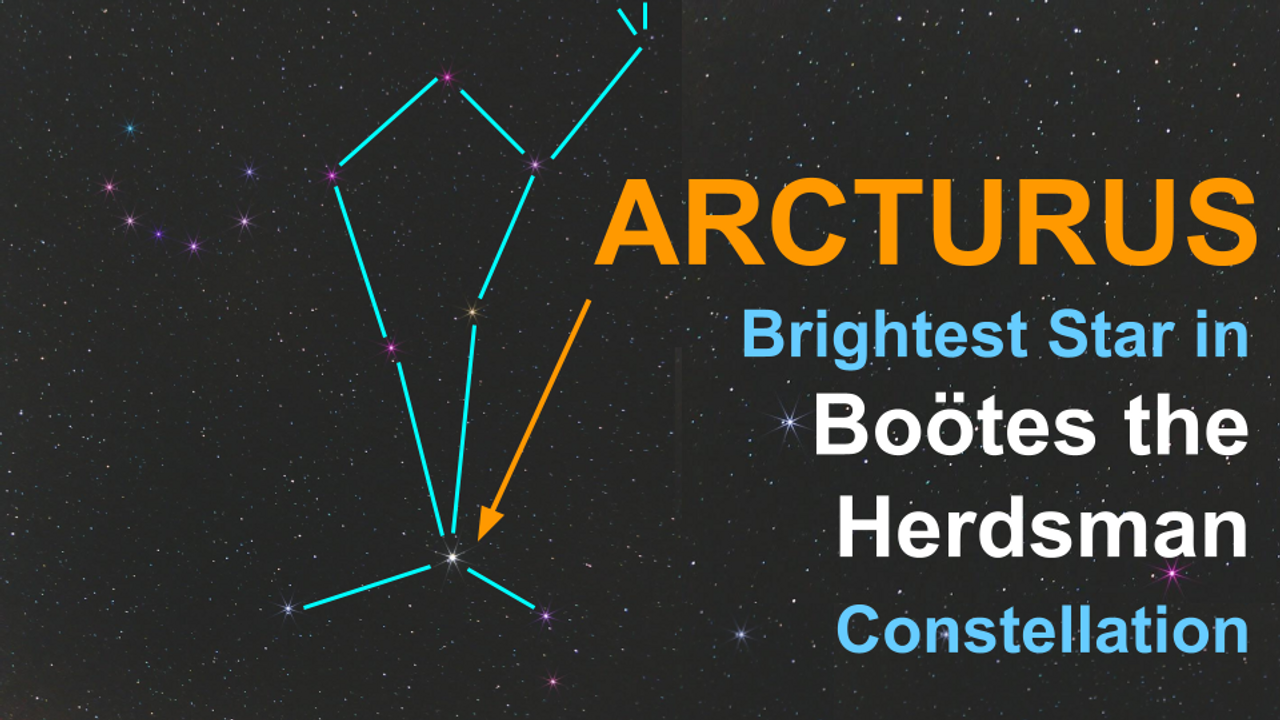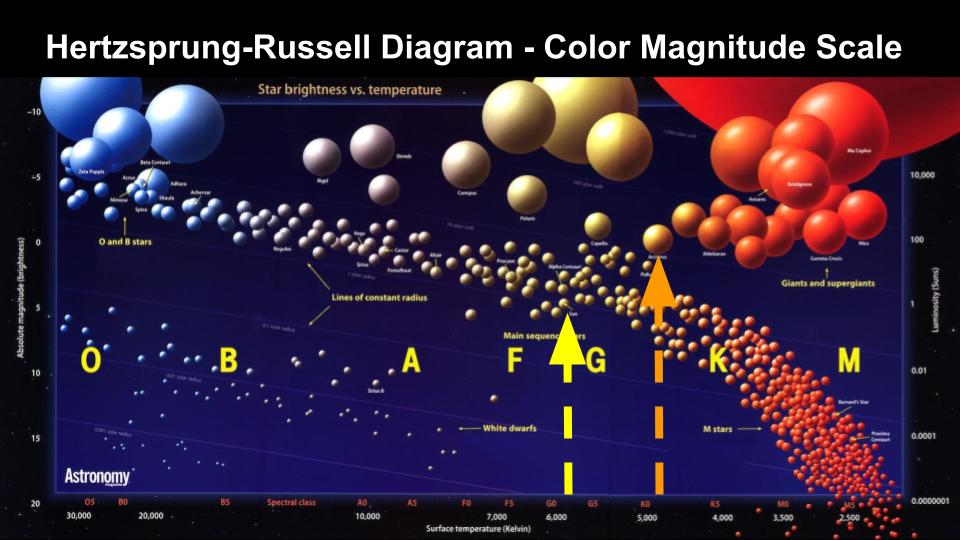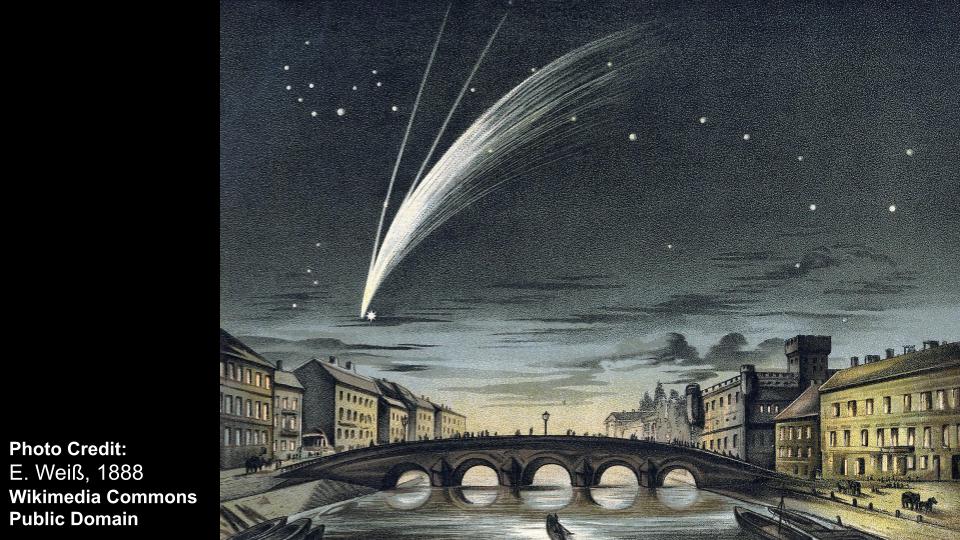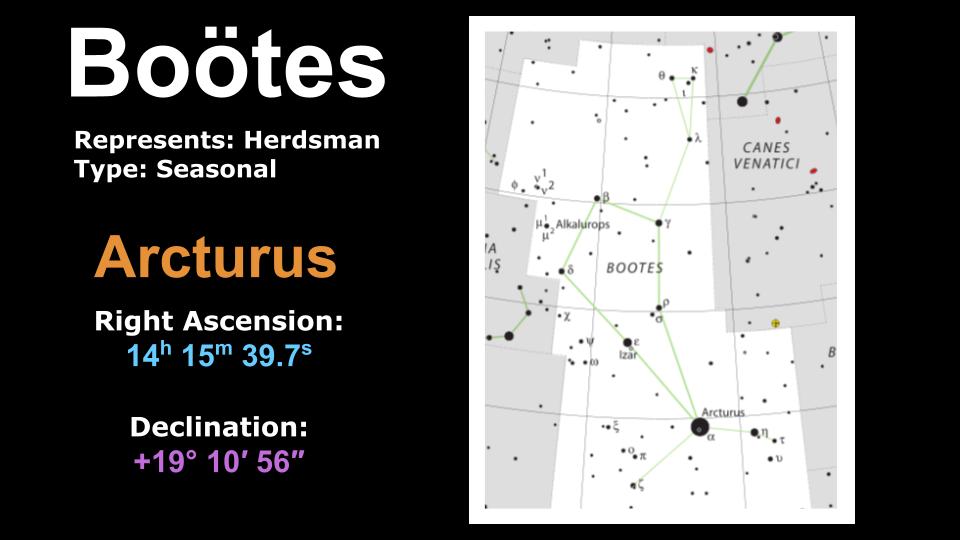Arcturus Star in Boötes
Aug 27, 2022
Arcturus: The 4th Brightest Star in the Night Sky
When looking at the night sky, it is common for your eye to be drawn to the Big Dipper. The Big Dipper, also called the plow in some other places of the world, can be very helpful in navigating other parts of the sky. You can use the Big Dipper to “Arc to Arcturus”, a bright star in the constellation of Boötes.
Characteristics of Arcturus
Arcturus is the fourth brightest star in the night sky. The reason it shines so bright in the sky is due to its size and distance. It's classified as a red giant star (Class K 1.53) and its distance is estimated to be 36.7 light years away, which is fairly close to us.
HR Diagram:
The HR diagram is a logarithmic color-magnitude scale that gives information on color, temperature, and luminosity. In this diagram, there is the main sequence band. When a star is in the main sequence band it means that a star is stable in terms of its gravity and fusion. A star spends 90 percent of its life in the main sequence stage. The chart is organized by temperature horizontally. The hottest stars are on the right, while the coolest stars are on the left.

Arcturus is about the same mass as our sun, but it's much bigger. That's because Arcturus is in a later stage of its life. Our sun will obtain similar characteristics to Arcturus towards the end of its life. So, Arcturus's mass is 1.08 times the mass of the sun. Its size is 25.4 solar radii, making it 170 times more luminous than our sun.
Arcturus is a cool star (4,200 Kelvin) when compared to our own Sun (6,000 Kelvin). Its age is estimated to be 7 billion years old, while our sun is estimated to be 5 billion years old.
How To Find Arcturus
Arcturus can be seen everywhere in the Northern Hemisphere and up to 50 degrees South latitude in the Southern Hemisphere. It's relatively easy to spot in the sky because it's bright and it's orange in color. It is located in the constellation of Boötes, which is seated next to Corona Borealis constellation (Corona Borealis Blog Post Link). When identifying Arcturus in the night sky, first identify the Big Dipper. From the handle of the Big Dipper, you Arc to Arcturus (The other half of that saying is: speed to Spica). This technique should allow you to identify Arcturus quickly.
 By E. Weiß - E. Weiß: "Bilderatlas der Sternenwelt" This file was derived from: Bilder-Atlas der Sternenwelt - eine Astronomie fur jedermann 1888 (128495337).jpg, Public Domain, https://commons.wikimedia.org/w/index.php?curid=254647
By E. Weiß - E. Weiß: "Bilderatlas der Sternenwelt" This file was derived from: Bilder-Atlas der Sternenwelt - eine Astronomie fur jedermann 1888 (128495337).jpg, Public Domain, https://commons.wikimedia.org/w/index.php?curid=254647
You can also find Arcturus by plugging the right Ascension and declination into your telescope. The right Ascension of Arcturus is 14h 15m 39.7s, and the declination is +19° 10′ 56″. Right Ascension is a celestial coordinate that measures the east-to-west coordinates. It's similar to longitude with Earth coordinates and is measured in hours, minutes, and seconds. Declination measures the north-south coordinates, and it's synonymous with latitude if you were to compare it to Earth coordinates. It is measured in degrees, arc minutes, and arc seconds.
Another tool for finding Arcturus is a star map from the International Astronomical Union. These maps are used to standardize constellation boundaries to ensure astronomers are all on the same page as stars are cataloged. On the star map of Boötes, Arcturus is larger because it's a brighter star. So the size of stars on Star Maps relates to their apparent magnitude and how bright it is.

History/Mythologies of Arcturus:
Arcturus is a Latinized Greek name that means 'arktouros', meaning 'the guard' or 'guardian of the bear". It is represented as a herdsman. So Ursa Major is the Great Bear, and the herdsman is protecting it. There are as many mythologies about constellations as there are stars, so there is no one correct mythology. In ancient maps, you can see Arcturus holding two dogs which Canis Venatici represents. Arcus, the son of Zeus and a demi-god, also represented Boötes.

Arcturus is a very important star in Polynesia and is called Hōkūleʻa. In prehistoric Polynesia, navigators knew Arcturus as Hōkūleʻa, also called the Star of Joy, used this star to launch their double-hulled canoes from Tahiti and the Marquesas island. Arcturus is the zenith star of the Hawaiian Islands. Polynesian Navigators traveled north and east, crossed the equator, and learned where Hawaii was. This is why Hōkūleʻa is a significant star to the Polynesians.

